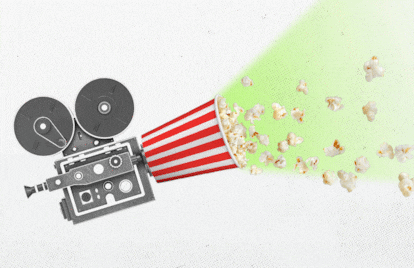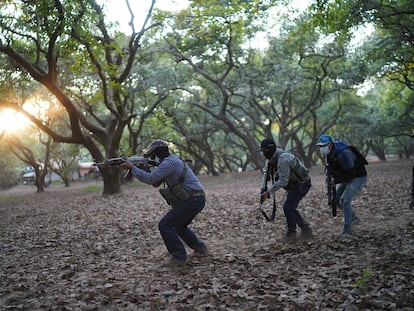Why do we eat popcorn at the movies?
The history of popcorn begins approximately 10,000 years ago in Mesoamerica, present-day Mexico, where the cultivation of corn was domesticated for the first time

The world is an extraordinary place! There’s not a day that goes by that doesn’t give us a reason or two to sit back on the couch with a bucket of popcorn and enjoy the show.
The folklore of some Native American groups tells stories about the spirits that inhabit the heart of corn kernels. These good-natured beings live happy, content lives of solitude, but become terribly angry when they feel heat. Any type of heat upsets them. The higher the temperature in their homes, the angrier they get; they can become so angry that they fly into a rage, violently shake the walls of the kernels in which they dwell in protest, and blow up their own homes. That is how popcorn is made.
Much less interesting are the facts that define a kernel of corn as 4% water enclosed in a cabinet lined with starch cushions and hermetically sealed on the outside by a hard shell. When that water is heated, it expands and exerts pressure against the walls of the cabinet, until the outer shell cannot support it and bursts, turning the kernel of corn inside out like a sock and exposing a fluffy mass of puffy starch that looks like a small white pigeon.
The history of popcorn begins approximately 10,000 years ago in Mesoamerica, present-day Mexico, where the cultivation of corn was first domesticated. The oldest ears of popcorn ever found were discovered in west-central New Mexico’s Bat Cave in 1948 and 1950; they are about 5,600 years old. Nearly 1,000-year-old popcorn kernels were found in tombs on the east coast of Peru; they are so well-preserved that they would still pop today.
But where does the connection between popcorn and entertainment come from?
We must begin with the importance of corn cultivation in the Americas. When a food is so well adapted to the environment and it is abundant and cheap, it is easy for it to appear anywhere in any situation and context for consumption and become a source of nutrients and business. In areas where its cultivation was significant, corn was the carbohydrate around which traditional cookbooks revolved. But its boom as a snack in the form of popcorn began in the 1890s with street vendors pushing carts among the crowds at fairs, parks, expositions and sporting events, and it exploded in popularity with the Golden Age of Hollywood in the 1920s and 1930s.
At that time, it was forbidden to eat anything in theaters, which were luxurious, upholstered and padded spaces for refined audiences. However, with the 1927 advent of films with sound that made it possible to enjoy films without knowing how to read subtitles, and then the onset of the Great Depression after the 1929 stock market crash, which left large masses of people unemployed, the movies became an affordable mass entertainment option for all audiences.
Spending an entire session on an empty stomach became an uphill struggle, and moviegoers would buy bags of popcorn for five or ten cents from street vendors before entering the theater and sneak them inside under their coats. Quickly, movie theater entrepreneurs understood that taking a stand against popcorn was a losing battle. They realized that if they let the street vendors set up shop in the lobby of the theater and collected a commission on sales instead of watching customers cheat them, they were in business.
Recently, Greenpeace’s spectacle of a campaign promoting avocado consumption in the middle of a drought has had a few of us eating popcorn. Why would a self-proclaimed environmentalist organization be promoting a non-native ingredient whose cultivation requires huge amounts of water? Why advocate for a crop that is responsible for serious conflicts related to arms trafficking, drug trafficking, misery and deforestation in Latin America and for bringing the Axarquia region in Malaga, Spain, to the brink of desertification?
“Now, when you go to make your shopping list, you will know how to choose what is best for your health, your pocket and for the planet. Fruits and vegetables whose origin is thousands of miles away and that have a high cost for the environment and people will be left behind,” Greenpeace tells us in the article that accompanies the advertisement.
Faced with such heights of irresponsibility and cynicism, I get hot. The little kind spirits that dwell within me rebel against my change in temperature, they get agitated, they get riled up, they push my walls and poof, that’s where my columns come from.
Sign up for our weekly newsletter to get more English-language news coverage from EL PAÍS USA Edition
Tu suscripción se está usando en otro dispositivo
¿Quieres añadir otro usuario a tu suscripción?
Si continúas leyendo en este dispositivo, no se podrá leer en el otro.
FlechaTu suscripción se está usando en otro dispositivo y solo puedes acceder a EL PAÍS desde un dispositivo a la vez.
Si quieres compartir tu cuenta, cambia tu suscripción a la modalidad Premium, así podrás añadir otro usuario. Cada uno accederá con su propia cuenta de email, lo que os permitirá personalizar vuestra experiencia en EL PAÍS.
¿Tienes una suscripción de empresa? Accede aquí para contratar más cuentas.
En el caso de no saber quién está usando tu cuenta, te recomendamos cambiar tu contraseña aquí.
Si decides continuar compartiendo tu cuenta, este mensaje se mostrará en tu dispositivo y en el de la otra persona que está usando tu cuenta de forma indefinida, afectando a tu experiencia de lectura. Puedes consultar aquí los términos y condiciones de la suscripción digital.
More information
Archived In
Últimas noticias
Maduro pleads not guilty before the federal court in New York: ‘I am still the president of Venezuela’
A new test can detect Alzheimer’s from a finger prick
UN team enters Sudanese city of El Fasher after paramilitary massacre: ‘It’s like a ghost town’
A recipe for resistance: Indigenous peoples politicize their struggles from the kitchen
Most viewed
- Gilles Lipovetsky: ‘If you want to live better and fall in love, take Prozac, don’t look to philosophy’
- Alain Aspect, Nobel laureate in physics: ‘Einstein was so smart that he would have had to recognize quantum entanglement’
- Alvin Hellerstein, a 92-year-old judge appointed by Bill Clinton, to preside over Maduro’s trial in New York
- Why oil has been at the center of Venezuela-US conflicts for decades
- Maduro’s downfall puts China’s relationship with Venezuela to the test











































